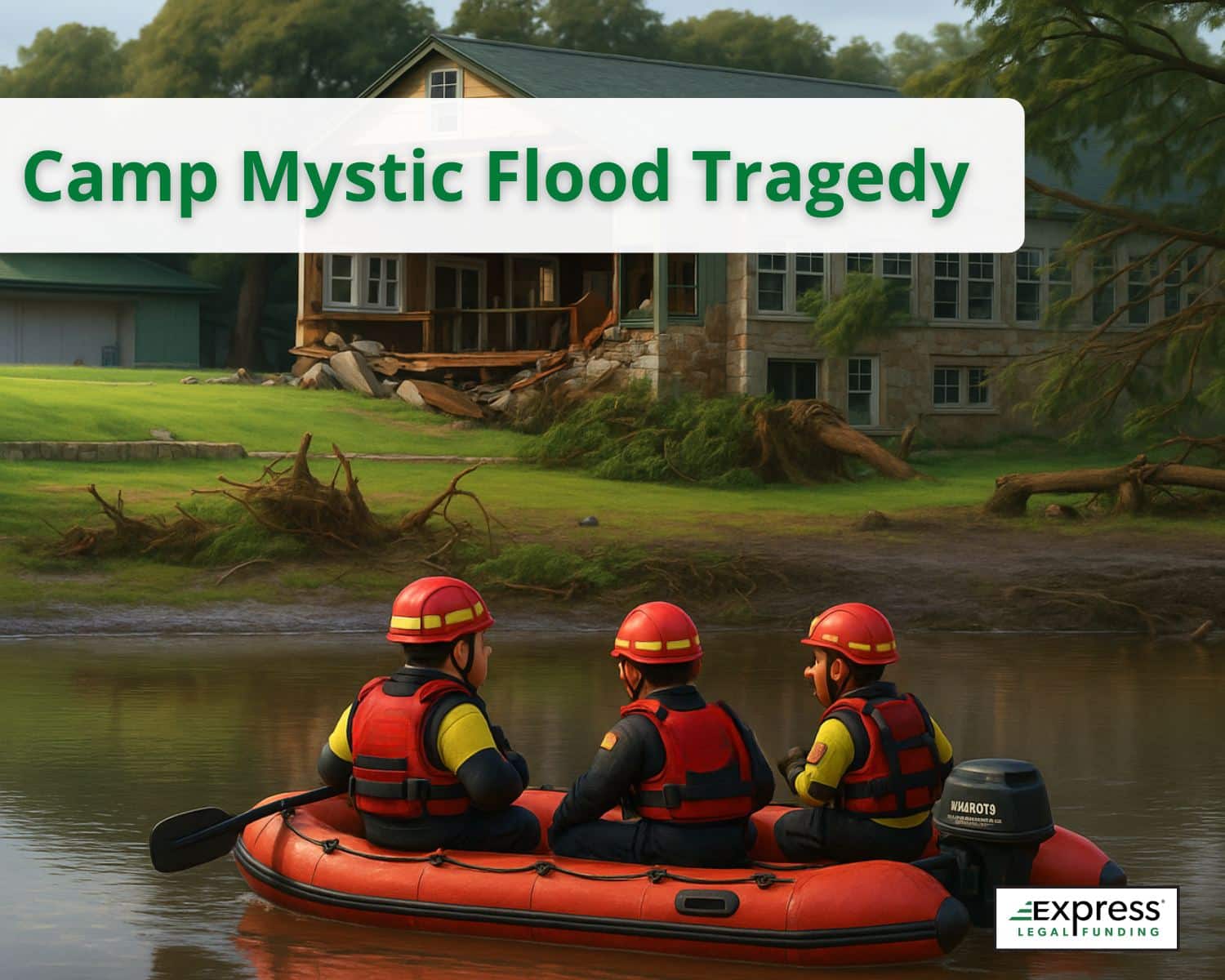
Camp Mystic Flash Flood: A Deadly Disaster That Could Have Been Prevented
In the early morning of July 4, 2025, a catastrophic flash flood swept through Camp Mystic, a historic all-girls summer camp located along the Guadalupe River in Hunt, Texas.
What should have been a joyful Independence Day turned into a nightmare as fast-rising waters inundated the camp, destroying riverside cabins and claiming the lives of dozens of young girls.
Although flash floods are common in Texas Hill Country’s “Flash Flood Alley,” this disaster was not entirely unpredictable.
The National Weather Service issued flood watches and flash flood warnings hours in advance, yet Camp Mystic allegedly failed to evacuate in time, leaving the youngest campers in the most dangerous low-lying cabins closest to the river.
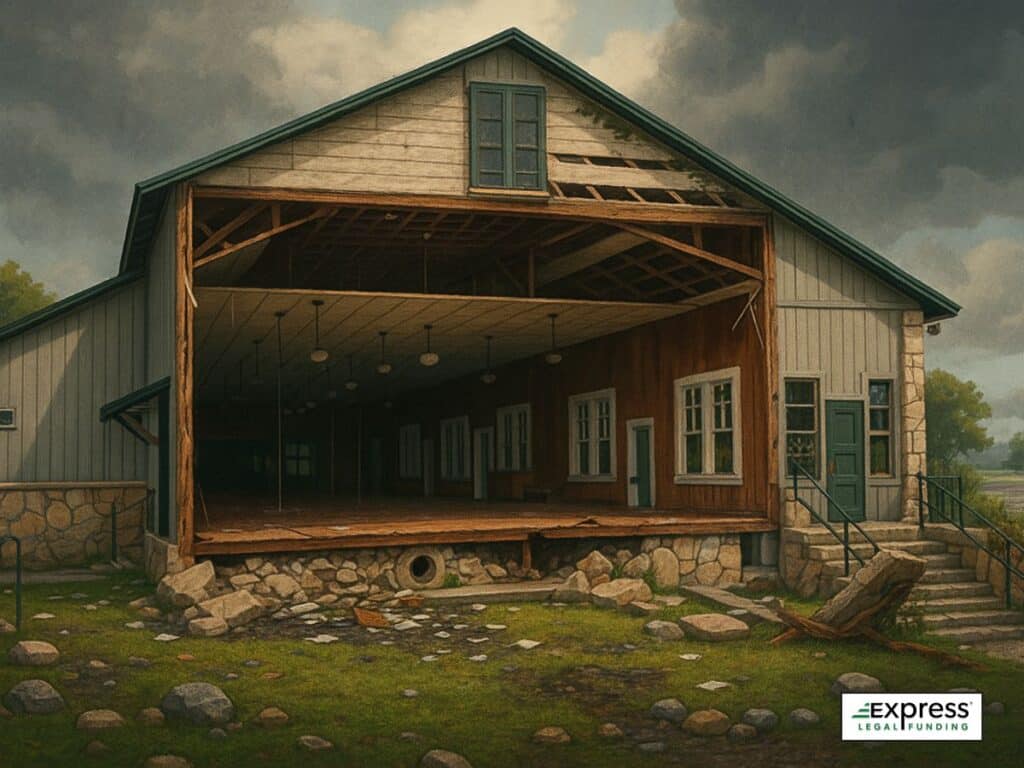
In the wake of this tragedy, grieving families are beginning to explore their legal options. Many are preparing to file wrongful death, negligence, and premises liability claims against Camp Mystic, its owners, and potentially government agencies accused of failing to implement life-saving safety measures.
At the same time, these families are facing mounting financial burdens, from funeral expenses and medical bills to relocation costs and trauma counseling. All while legal proceedings are just beginning and compensation remains uncertain.
This comprehensive guide outlines what happened at Camp Mystic, who may be held legally responsible, what types of lawsuits victims’ families can file, and how pre-settlement legal funding works to provide immediate financial relief while their cases move through the court system.
If your child was injured or if you tragically lost a loved one in the Camp Mystic flood, this guide is here to help you understand your legal rights, explore your options, and find the support your family needs during this incredibly difficult time.
What is the Camp Mystic Flood Tragedy?
The Camp Mystic Flood Tragedy refers to the deadly flash flood on July 4, 2025, that struck Camp Mystic, an all-girls summer camp on the Guadalupe River in Hunt, Texas. The disaster claimed dozens of lives, including young campers and staff, after the river rapidly overflowed and inundated the campgrounds.
Where is Camp Mystic located?
Camp Mystic is a private Christian summer camp for girls located in Hunt, Texas, along the banks of the Guadalupe River. It lies in the heart of the Texas Hill Country’s “Flash Flood Alley,” a region nationally recognized for its steep terrain, narrow river valleys, and frequent, fast-moving flash floods.
Camp Mystic Flood Timeline: From Ignored Warnings to Catastrophe

The devastating Camp Mystic flood was not a sudden, unpredictable event—it unfolded across several days with clear warning signs that were tragically overlooked. Below is a detailed timeline of the key events that led to one of the deadliest flash floods in Texas history:
July 1–3: Tropical Storm Barry’s Remnants Increase Rainfall Risk
- Tropical Storm Barry made landfall in northeastern Mexico, only a few hundred miles south of the Texas Hill Country.
- Its remnants pumped moisture into Central Texas, creating unstable weather conditions that significantly increased the risk of flash flooding in flood-prone areas like Kerr County.
July 3, 2025 – Early Weather Alerts and Missed Warnings
- Afternoon: The National Weather Service (NWS) issued a Flood Watch for the Texas Hill Country, including Kerr County, warning of the potential for heavy rainfall and flash flooding due to a stalled weather system.
- Evening: Multiple local meteorologists echoed alerts on social media and news broadcasts, cautioning that conditions were ideal for sudden river surges along the Guadalupe River.
July 4, 2025 – Hour-by-Hour Breakdown of the Flood
- 1:14 a.m.: The NWS upgraded its advisory to a Flash Flood Warning for Kerr County, Hunt, and surrounding areas. This alert was meant to trigger immediate protective actions, especially in known flood zones.
- 2:30–3:30 a.m.: Rainfall intensified across Central Texas. Emergency scanners began reporting rising water levels in creeks and rivers. Despite this, no countywide flood sirens were activated near Camp Mystic.
- Around 5:00 a.m.: The Guadalupe River surged over 20 feet in less than an hour. Water inundated Camp Mystic’s riverside cabins, many of which housed the youngest campers. Witnesses described the water as arriving “like a freight train.”
- 5:30 a.m.: Initial 911 calls were made as floodwaters swept away buildings, people, and vehicles. Some survivors clung to trees or rooftops awaiting rescue.
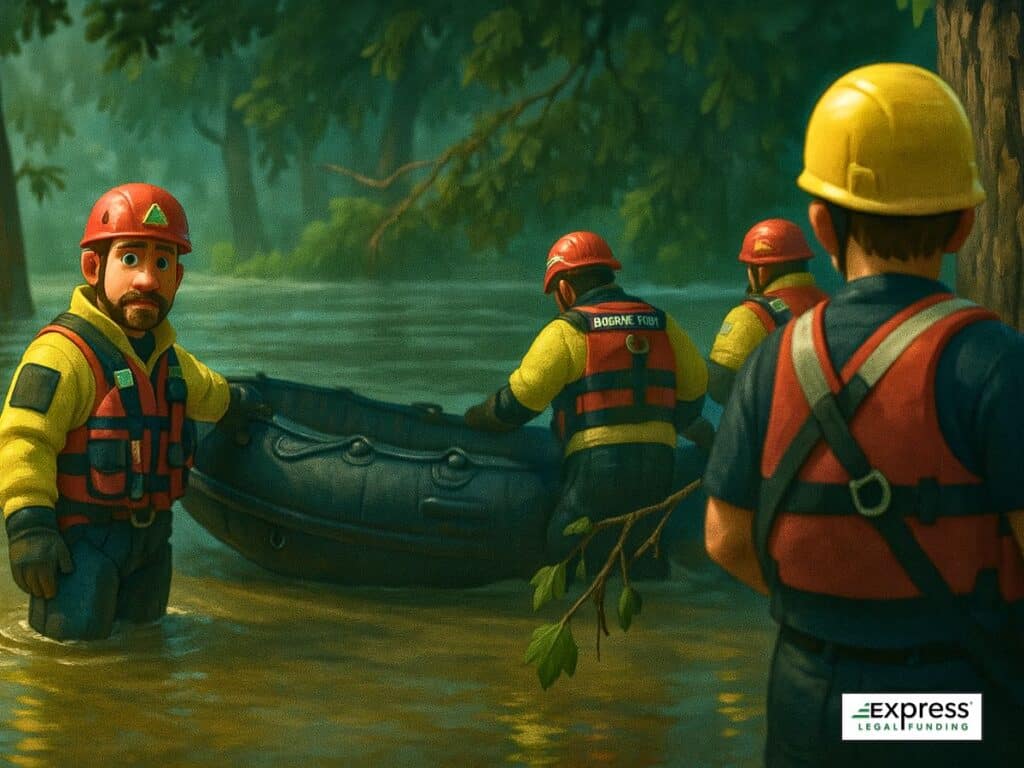
July 4, 2025 – Rescue Efforts and Rising Death Toll
- 6:00–10:00 a.m.: A multi-agency rescue operation began. Texas National Guard helicopters and Coast Guard teams conducted aerial rescues. Local ranchers and volunteers also joined in boat rescues along the Guadalupe.
- 11:00 a.m.: Camp Mystic officials released a statement confirming extensive flooding but did not initially provide casualty numbers.
July 5, 2025 – Families Search for Answers
- Throughout the day, families of campers gathered at staging areas in Hunt and Kerrville seeking information. Grief counselors were dispatched to assist.
- Texas Governor Abbott issued state emergency declarations for Kerr and adjacent counties as the disaster response escalated.
July 6, 2025 – Governor Abbott’s Site Visit and Public Warning
- Morning: Governor Greg Abbott visited Camp Mystic, calling the scene “nothing short of horrific.”
- Afternoon Press Conference: At the State Operations Center in Austin, Gov. Abbott warned of ongoing dangers in Central Texas and urged citizens: “If there’s any water on the road, the most important thing you can do is to protect your lives. Remember: Turn Around, Don’t Drown.”
- Abbott also reported that over 1,500 emergency responders and 925+ search and rescue assets were deployed statewide.

July 7, 2025 – Death Toll Confirmed, Recovery Underway
- Confirmed fatalities: Texas officials have announced that 27 individuals from Camp Mystic, including campers, staff members, and the camp’s owner Dick Eastland, were among the more than 119 people killed in the catastrophic floods across Central Texas.
- Search efforts: Recovery missions continued, focusing on locating those still missing and assessing the damage to camp structures.
Flash Flood Alley: Why the Texas Hill Country Is So Dangerous
The tragedy at Camp Mystic wasn’t an unpredictable act of nature—it occurred in one of the most flood-prone regions in the country. Known as Flash Flood Alley, this stretch of Central Texas, including Hunt and Kerr County, consistently ranks among the deadliest flood zones in the United States.
What Is Flash Flood Alley?
Flash Flood Alley is a high-risk flood zone in Central Texas, stretching from San Antonio through Austin and into the Hill Country. Known for some of the most frequent and deadly flash floods in the United States, this region sees rivers rise more than 20 feet in under an hour. The area’s steep terrain, thin soil, and intense storm patterns make it especially prone to rapid, life-threatening flooding.
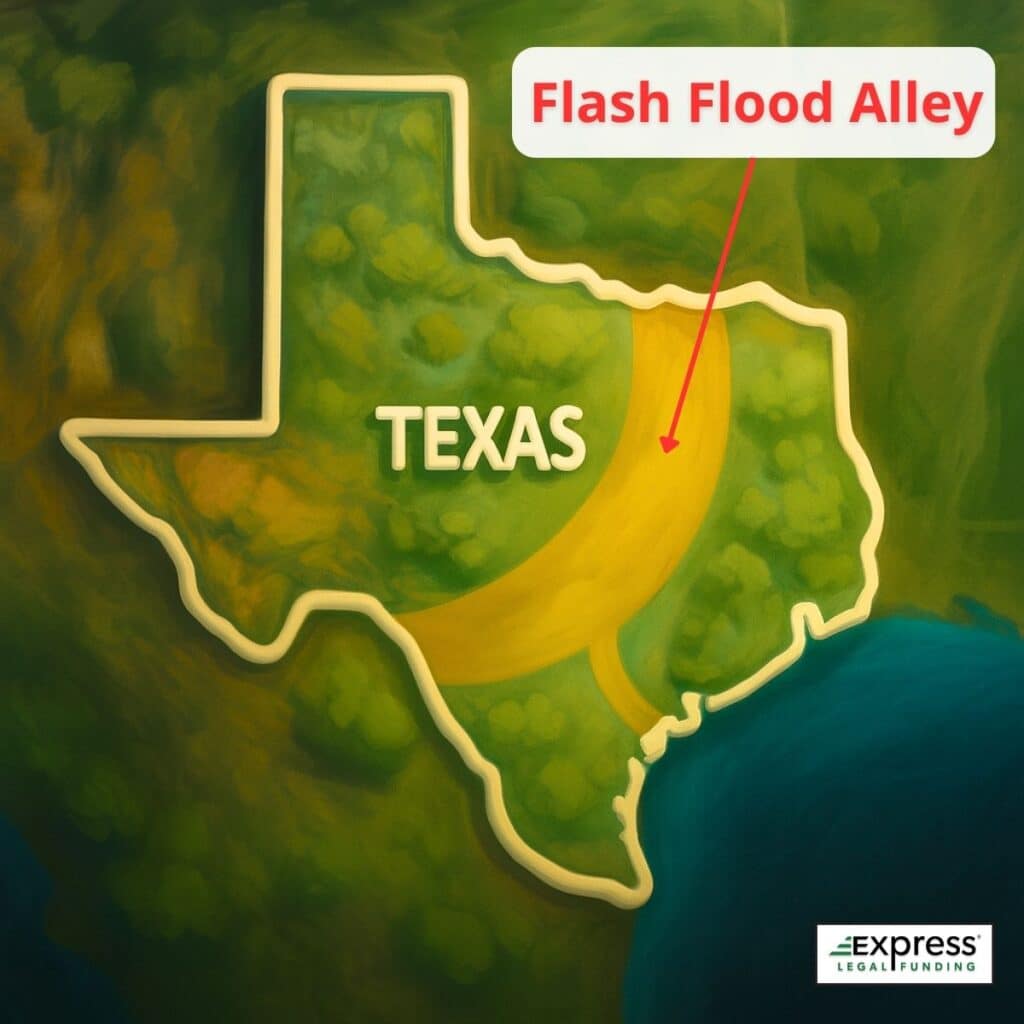
What Makes This Region Prone to Flash Floods
Key reasons why floods are so common in Flash Flood Alley:
- Steep limestone hills: Rainwater races downhill with little resistance.
- Shallow, rocky soil: Limits water absorption, causing rapid surface runoff.
- Storm intensity: Warm Gulf moisture fuels powerful thunderstorms that drop multiple inches of rain in hours, or even minutes.
These flash flood conditions are worsened by the fact that many camps, cabins, and residential areas are built along scenic rivers like the Guadalupe, right in the floodplain.
History of Deadly Flooding in Kerr County and Central Texas
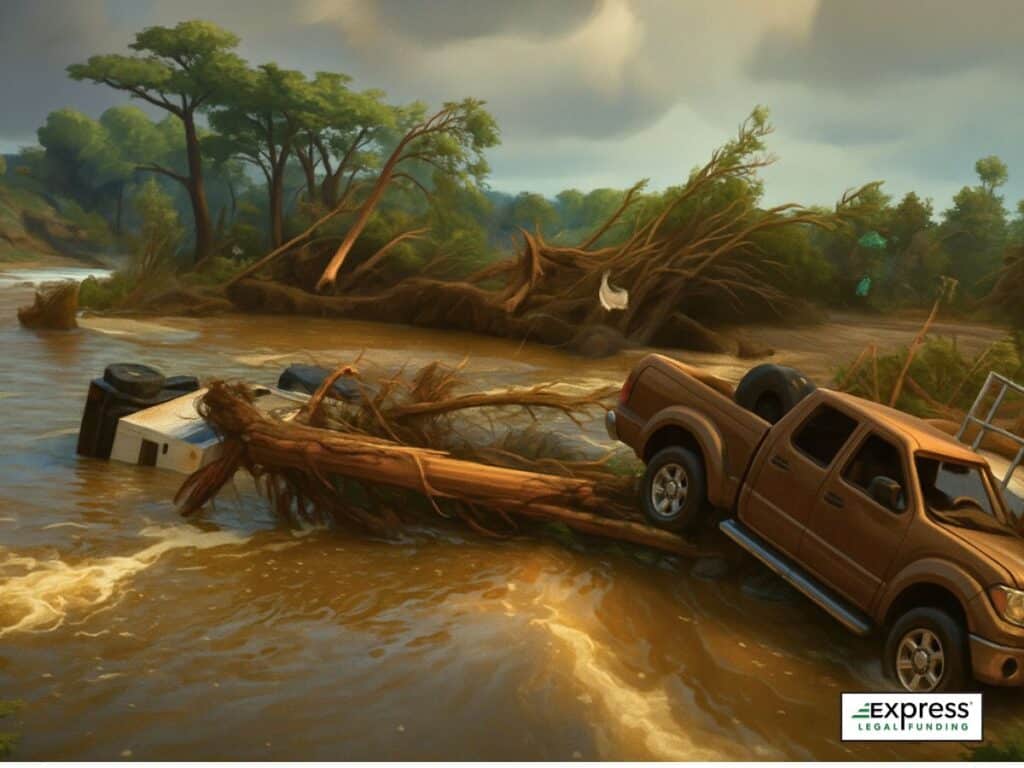
The risks in Flash Flood Alley are not theoretical. Kerr County and the surrounding region have suffered multiple catastrophic floods over the past few decades:
- 1987 Guadalupe River Flood: Caused widespread destruction and 10 deaths—one of the earliest warnings of the region’s flood dangers.
- 2002 Central Texas Flooding: Killed 215 people and brought national attention to outdated infrastructure and warning systems.
- 2015 Memorial Day Floods: Considered a 100-year flood and resulted in several deaths across the Hill Country, prompting demands for sirens and better emergency protocols.
Despite these disasters, many outdoor camps—including Camp Mystic—did not install flood warning systems, sirens, or effective evacuation procedures.
How Flash Flood Alley Impacts Camp Mystic Lawsuit Claims
The fact that Camp Mystic is located directly within Flash Flood Alley may play a crucial role in upcoming wrongful death and negligence lawsuits. Plaintiffs can argue that the camp’s owners had a legal and moral duty to prepare for known flood risks, especially during summer months when storms are frequent and deadly.
This geographic context supports legal claims of:
- Negligence: Failing to implement reasonable safety measures despite known flood dangers.
- Premises liability: Housing children in cabins within FEMA flood zones without adequate emergency systems.
- Gross negligence: Ignoring decades of weather alerts, flood patterns, and previous tragedies in the same area.
Why Geography Matters in Flood Lawsuits
Flash Flood Alley isn’t just a weather term—it’s a legally relevant designation that strengthens claims of foreseeable danger. Courts often consider past events, geographic risks, and regional warnings when determining whether a defendant acted with reasonable care.
Ignored Flood Warnings at Camp Mystic: A Preventable Tragedy That Claimed Young Lives
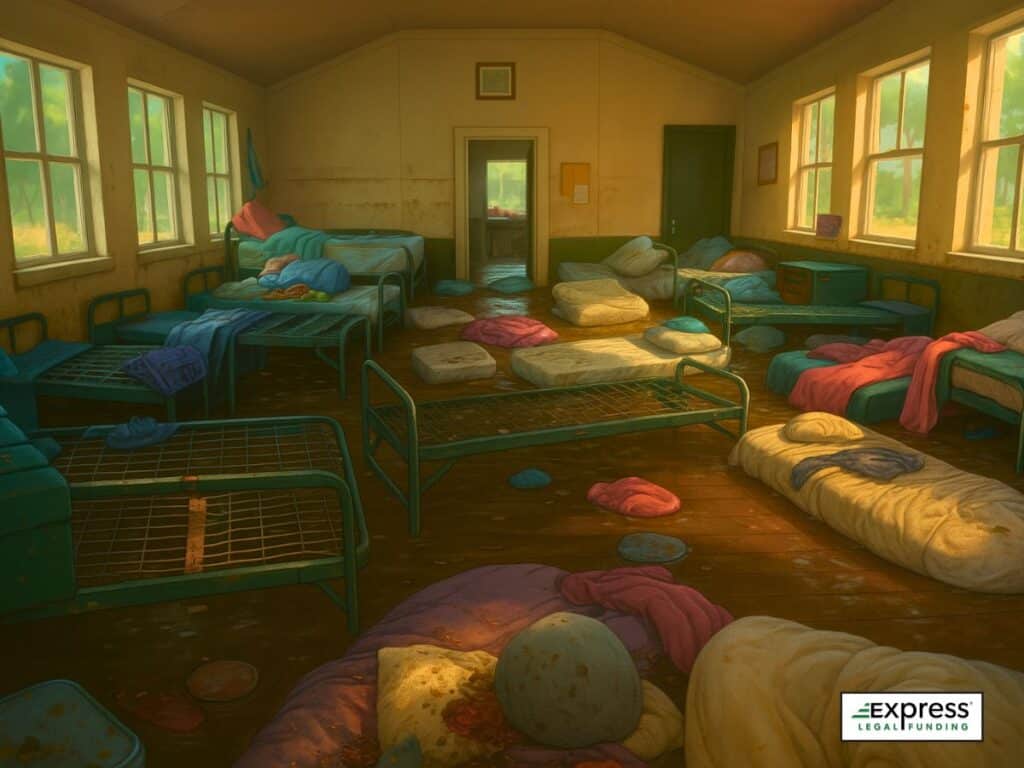
Although the flash flood that struck Camp Mystic on July 4, 2025, was intense and fast-moving, this disaster wasn’t simply the result of severe weather—it was the consequence of critical human failures. Experts and grieving families agree: the Camp Mystic flood deaths were preventable.
Despite being located in Flash Flood Alley, where deadly flooding is a well-known danger, the camp lacked even the most basic flood preparedness and warning systems. When the Guadalupe River surged over 20 feet in the early morning hours, children and staff had little to no chance to escape in time.
Major Safety Failures at Camp Mystic
Here are the key factors that contributed to the loss of life:
- No Flood Sirens or Audible Alerts: Kerr County had no outdoor sirens to alert residents or wake campers during the nighttime emergency.
- At-Risk Cabin Placement: The youngest campers were housed in the cabins closest to the river, placing them directly in the flood’s path.
- Delayed Evacuation Response: Even though the National Weather Service issued a flash flood warning at 1:14 a.m., no meaningful evacuation occurred until it was too late, around 5:00 a.m., when floodwaters had already surged.
- No Internal Alert System: Camp Mystic had no internal flood alarm system, text alert network, or overnight staff protocol to notify and move sleeping children quickly.
How Camp Mystic’s Flood Response Compared to Other Texas Summer Camps
Neighboring summer camps along the Guadalupe River, such as Mo-Ranch, which was affected by the same storm system, were able to evacuate or shelter their campers in time before the floodwaters rose.
Their preparedness stands in stark contrast to the lack of action at Camp Mystic.
This disparity highlights a systemic failure in leadership and planning. The absence of safety infrastructure, delayed decisions, and failure to act on official warnings turned a natural hazard into a mass casualty event.
Who Could Be Held Liable for the Camp Mystic Deaths and Injuries?
The tragic loss of life at Camp Mystic wasn’t just the result of nature—it may have stemmed from serious negligence by multiple parties. As investigations continue, several individuals and entities could face legal liability for their role in this preventable disaster.
Potential Defendants in Camp Mystic Flood Lawsuits
1. Camp Mystic and Its Owners: Dick and Tweety Eastland
Camp Mystic is a private, for-profit Christian summer camp that charges families over $4,000 per child for two-week sessions. Despite its premium cost and location directly on the banks of the Guadalupe River in a FEMA-designated flood zone, the camp has come under scrutiny for serious safety shortcomings.
Reports allege that:
- The youngest campers were housed in the lowest-lying cabins closest to the river, placing the most vulnerable in the highest-risk area.
- Camp leadership failed to act decisively on prior flood warnings and real-time weather alerts, even after the National Weather Service issued a flash flood warning at 1:14 a.m. on July 4, 2025.
- The camp lacked internal flood alert systems such as sirens or structured evacuation protocols, which delayed critical action during the rising floodwaters.
These alleged failures are now at the center of ongoing investigations and potential wrongful death and negligence lawsuits by victims’ families.
2. Upper Guadalupe River Authority (UGRA)
The Upper Guadalupe River Authority (UGRA) is responsible for managing water and flood safety in Kerr County. After the Camp Mystic flood, UGRA is facing criticism for not doing more to prevent the disaster.
Key concerns include:
- Years of Inaction: After deadly floods in 2015, UGRA discussed adding sirens and warning systems. But those talks stalled due to cost, pushback from rural residents, and red tape. No new systems were in place by the time of the Camp Mystic flood.
- Ties to Camp Mystic’s Owner: Camp Mystic’s owner, Dick Eastland, was appointed to UGRA’s board in 2022 and served as treasurer. This close connection has raised concerns about a conflict of interest, especially since UGRA helps make decisions about flood safety in the same area where Camp Mystic is located.
These issues may be important in future lawsuits. Families and officials could question whether UGRA failed in its duty to protect the public and whether its leadership was too closely tied to the camp to act independently.
3. Kerr County and Texas State Officials
Despite the Texas Hill Country’s well-documented vulnerability to flash flooding, Kerr County and state authorities had not installed critical outdoor warning systems or real-time river alert infrastructure in the region before the July 4, 2025, flood. These gaps in preparedness may face increasing legal and public scrutiny.
Key concerns include:
- No Outdoor Flood Sirens: At the time of the flood, Kerr County had no sirens to alert residents or camps. County officials had discussed installing them for years, but efforts stalled due to cost, opposition from rural landowners, and delays in getting federal grants. After the flood, officials admitted that sirens would likely have helped.
- Unfunded Flood Warning Systems: Since 2016, Kerr County had sought grants to modernize its flood monitoring system. A $50,000 study outlined what was needed, but the county never secured the estimated $1 million required. As a result, outdated gauges and limited real-time alerts remained in place.
- No Requirements for Camps in Flood Zones: Many summer camps, including Camp Mystic, are located in FEMA-designated floodplains. However, Texas law does not require these camps to create or follow emergency flood plans. This regulatory gap is now drawing attention from both lawmakers and attorneys representing victims’ families.
These shortcomings may form the basis for future legal claims or legislative changes, especially as grieving families seek accountability from public institutions they believe failed to protect their children.
Legal Grounds: Why Camp Mystic and State Agencies May Be Held Liable
The central legal argument in these potential lawsuits is that decisions—or the lack thereof—by people in power directly endangered vulnerable children. Lawyers will likely focus on the foreseeability of the flood risk, the known safety deficiencies, and the apparent disregard for warnings.
If your family has been affected, consult with a qualified wrongful death or personal injury attorney in Texas to begin exploring your legal rights and potential compensation.
Legal Options for Victims’ Families After the Camp Mystic Flood
For the families who lost children or whose loved ones were injured in the Camp Mystic flood, the law offers multiple avenues to seek justice and financial compensation. These lawsuits are not only about accountability—they can help cover overwhelming costs like funeral expenses, medical bills, and future care needs.

Filing a Wrongful Death Lawsuit
Families of victims who died due to the flood may pursue wrongful death claims against Camp Mystic or other responsible parties. These lawsuits seek compensation for:
- Funeral and burial expenses
- Emotional suffering and loss of companionship
- Lost future earnings or support
Wrongful death claims are typically filed by parents or legal guardians under Texas Civil Practice and Remedies Code § 71.
Negligence Claims
A negligence claim may apply when a party fails to act with reasonable care, especially in the face of known dangers. In this case, possible negligence includes:
- Ignoring multiple weather alerts
- Failing to implement or activate flood safety protocols
- Delayed evacuation procedures after flash flood warnings
Negligence claims can be filed against private camp operators, government agencies, or other involved entities.
Premises Liability Lawsuits
Because Camp Mystic placed children in high-risk cabins near the river, victims’ families may file premises liability lawsuits. These claims focus on the camp’s failure to:
- Maintain a safe environment
- Warn occupants about known flood dangers
- Relocate campers away from the riverfront
Premises liability is especially relevant when the property owner profits from hosting others, like in a paid summer camp setting.
Potential Claims Against Public Agencies

In certain cases, government agencies like Kerr County or the Upper Guadalupe River Authority (UGRA) may be liable for failing to:
- Install public flood sirens
- Maintain adequate flood detection systems
- Enforce safety standards in flood-prone areas
Filing claims against public entities can be complex due to Texas sovereign immunity laws, but legal pathways exist when officials neglect clear duties that result in harm.
Take the First Step Toward Justice
If you’re uncertain about your legal options, it’s crucial to speak with a Texas wrongful death or personal injury attorney who has experience handling cases involving flood disasters, government liability, and institutional negligence.
A timely legal consultation can help preserve evidence, identify liable parties, and start the process of holding them accountable.
Pursuing a wrongful death or personal injury lawsuit is often the only path to justice after a preventable tragedy like the Camp Mystic flood. However, these legal cases are rarely resolved quickly, especially when they involve multiple defendants, insurance companies, or government entities.
Why Camp Mystic Lawsuits Could Take Months or Even Years to Resolve
While the facts surrounding the Camp Mystic flood may appear straightforward, legal cases—especially those involving multiple parties and government agencies—are rarely quick or simple. Several challenges can delay justice for victims’ families:
Insurance Delays and Coverage Disputes
Insurance companies often conduct lengthy investigations before accepting liability or approving claims. Even with clear evidence of negligence, insurers may deny, delay, or attempt to minimize payouts, especially in catastrophic cases involving multiple deaths and large financial exposure.
Complex Liability Questions
When several parties share potential blame—such as Camp Mystic’s owners, local officials, and river authorities—it takes time to determine legal responsibility. Sorting out who knew what, and when, often requires in-depth depositions, document reviews, and cooperation between legal teams.
Expert Testimony and Legal Analysis
Plaintiffs’ attorneys often rely on expert witnesses in meteorology, emergency management, and flood safety to build a strong case. These experts must analyze weather data, warning systems, cabin placement, and staff decisions, adding both time and cost to the litigation.
Legal Hurdles When Suing Government Agencies
Filing a claim against a public entity like Kerr County or the Upper Guadalupe River Authority involves strict notice requirements and potential sovereign immunity defenses. These legal obstacles can significantly slow progress or even prevent certain claims from going forward without meticulous preparation.
The Emotional Burden of Prolonged Litigation
For grieving families, the legal process can feel retraumatizing. Navigating court filings, interviews, and depositions while mourning a lost child or caring for an injured one adds a heavy emotional toll that can delay case momentum or lead to early settlements out of exhaustion.
Immediate Financial and Emotional Challenges for Camp Mystic Families
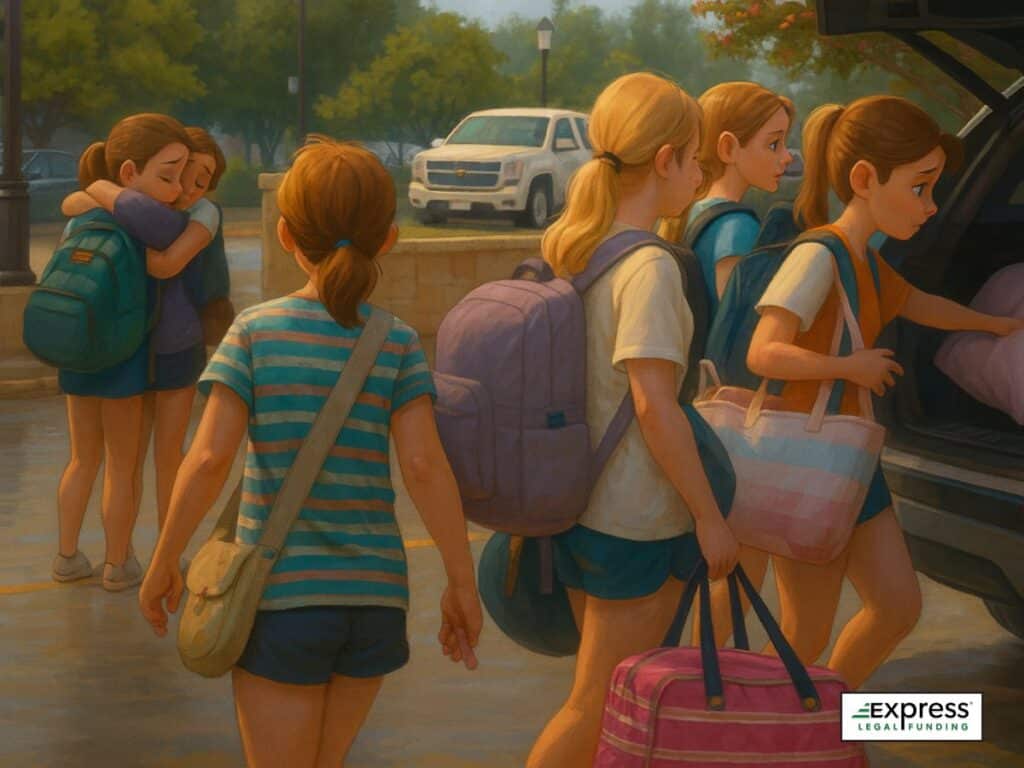
While the legal process may take months or even years, the hardships for families impacted by the Camp Mystic flood begin on day one. The costs of recovery are immediate and overwhelming.
Common Financial Pressures Include:
- Funeral and Burial Expenses: Grieving families face thousands in sudden, unplanned costs to lay their loved ones to rest with dignity.
- Trauma Counseling and Grief Support: Survivors and their families may require long-term mental health care to cope with the psychological impact.
- Lost Wages: Many parents have had to miss work or take unpaid leave to care for their children, attend legal meetings, or relocate.
- Medical Bills: Injured campers may need ongoing treatment, rehabilitation, or hospitalization, which are not covered by insurance.
- Emergency Housing and Relocation: Some families are temporarily displaced due to flood damage, requiring alternate lodging or relocation.
No one should be forced to choose between seeking justice and staying financially afloat.
Financial Help for Families Affected by the Camp Mystic Flood
If your family is preparing to file or has already begun the legal process following the Camp Mystic tragedy, you don’t have to wait for a verdict to get financial support.
One immediate solution is pre-settlement legal funding, which provides a risk-free lawsuit cash advance based on the expected outcome of your lawsuit.
- You can use the funds to cover essentials like rent, counseling, and funeral costs.
- You only repay if you win or settle your case.
- There are no credit checks or upfront fees.
This financial bridge can help you focus on healing and accountability, not just survival.
Pre-Settlement Legal Funding: A Lifeline for Families Impacted by the Camp Mystic Flood
In the aftermath of the Camp Mystic flood tragedy, grieving families face more than just emotional pain—they’re dealing with crushing financial burdens. Funeral costs, grief counseling, lost wages, and emergency housing can’t wait for a lawsuit to resolve, which could take months or even years.
That’s where pre-settlement legal funding becomes a critical tool. It provides fast, no-risk financial relief for families pursuing wrongful death or personal injury claims, without the stress or requirements of a traditional loan.
What Is Pre-Settlement Funding?
Pre-settlement funding is not a loan. It’s a non-recourse cash advance based on the projected outcome of your legal case. Here’s how it works:
- No Win, No Repayment: If your case doesn’t settle or win in court, you owe nothing.
- No Credit or Employment Checks: Approval is based on the strength of your legal claim, not your credit score or income.
- Fast Access to Cash: Most families receive funds within 24 to 48 hours of approval.
This funding acts as a financial bridge, helping families stay afloat while their attorneys build a strong case for justice and compensation.
How Families Are Using Pre-Settlement Legal Funding
Families affected by the Camp Mystic disaster are using their legal funding to:
- Cover funeral and burial expenses
- Pay for grief counseling and trauma therapy
- Manage day-to-day living costs like rent, groceries, and utility bills
- Fund emergency relocation or withdraw children from other summer programs
Instead of waiting in financial limbo, this option allows families to focus on healing and rebuilding—without sacrificing legal momentum.
Important Note: Pre-settlement funding is 100% risk-free. You only repay if your case results in a settlement or award.
In the next section, we’ll walk you through how to apply for pre-settlement funding and what you’ll need to qualify.
How to Apply for Pre-Settlement Funding After the Camp Mystic Flood
If your family is pursuing a wrongful death or personal injury lawsuit related to the Camp Mystic flood, you may be eligible for a lawsuit cash advance through Express Legal Funding. This financial support can help you manage urgent expenses while your case moves through the legal system.
Who Qualifies for Legal Funding?
To be eligible for pre-settlement funding, you must meet the following criteria:
- You have a licensed attorney representing you in an active wrongful death or personal injury claim related to the Camp Mystic flood.
- Your case shows evidence of negligence or preventable harm, such as delayed evacuations, lack of safety protocols, or failure to act on weather alerts.
- You’re facing financial hardship as a result of the tragedy and legal delays, such as struggling to cover funeral costs, counseling, or housing.
Fast, Risk-Free Application Process
Applying for pre-settlement funding is simple, fast, and completely confidential:
Call Express Legal Funding at (888) 232-9223 or apply online to find out how much funding you may qualify for.
No upfront fees. No credit checks. No repayment unless your case wins or settles.
Final Thoughts: Seeking Justice and Support After a Preventable Tragedy
The Camp Mystic flood was not just a weather event—it was a preventable tragedy rooted in negligence and system failures. For the families left behind, legal action is about more than compensation—it’s about accountability and reform.
Helpful Legal and Mental Health Resources
Legal Help:
Mental Health Support:
Helpful Tip:
Save all emails, texts, voicemails, medical records, and news articles related to the flood—they may strengthen both your lawsuit and your funding application.
If Your Family Was Impacted by the Camp Mystic Flood, You Deserve Support Now
You shouldn’t have to wait months—or even years—for a lawsuit to settle before getting the financial relief your family urgently needs. At Express Legal Funding, we provide fast, non-recourse legal funding to families affected by the Camp Mystic flood tragedy, so you can focus on healing and justice.
Even if you haven’t hired an attorney yet, we may be able to help. Our team can connect you with a trusted personal injury or wrongful death lawyer in your area who understands what you’re going through.
Apply online for legal funding or alternatively call us toll-free at (888) 232-9223 for a free consultation and to explore your options.
FAQs About the Camp Mystic Flood and Legal Rights
What happened at Camp Mystic in July 2025?
On July 4, 2025, a flash flood struck Camp Mystic in Hunt, Texas, killing at least 27 campers and staff. The Guadalupe River rose over 20 feet, sweeping away riverside cabins while most were still asleep.
Was the Camp Mystic flood tragedy preventable?
Yes, experts say the tragedy was preventable. Flash flood alerts were issued hours before the disaster. Camp Mystic lacked sirens, delayed evacuation, and housed its youngest campers closest to the river, unlike nearby camps that evacuated in time.
Who can be held liable for the Camp Mystic deaths?
Liable parties may include Camp Mystic’s owners, the Upper Guadalupe River Authority (UGRA), and Kerr County officials. Legal claims may involve negligence, wrongful death, or premises liability for failing to protect against known flood risks.
Will Camp Mystic be sued?
Yes. Families are already preparing wrongful‑death, negligence, and premises‑liability lawsuits against Camp Mystic (and possibly related parties) based on clear failures in evacuation procedures, ignored flood risks, and a history of similar incidents. Legal experts confirm litigation is expected and necessary to recover damages and ensure changes to prevent future tragedies.
Many cases are expected to proceed within the next two years, with survivors seeking accountability, answers, and compensation.
What legal options do victims’ families have?
Families can pursue:
- Wrongful death lawsuits against the camp or other responsible parties
- Negligence claims for ignoring safety protocols
- Premises liability for unsafe cabin placement
- Government liability for inadequate warning systems
How long do Camp Mystic lawsuits take to settle?
Lawsuits may take 12 to 36 months or longer. Delays can stem from insurance disputes, expert investigations, and resistance from public agencies. Multiple defendants may add to the timeline.
What is pre-settlement legal funding?
Pre-settlement funding is a non-recourse cash advance for plaintiffs with active lawsuits. You repay only if you win or settle. It helps families pay for funeral costs, therapy, housing, and other urgent expenses.
Can Camp Mystic victims’ families get legal funding?
Yes. Families with an attorney and a strong case may qualify for legal funding. There are no credit checks, and funds can be disbursed within 24–48 hours once approved.
How can I apply for pre-settlement funding?
You can apply through Express Legal Funding’s website or by calling directly at (888) 232-9223. The application is free, confidential, and risk-free.



